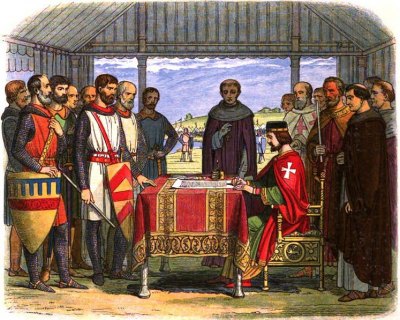What is the Magna Carta?

So what was the Magna Carta (also spelled Magna Charta), anyhow? The words translate to “Great Charter,” but there’s more to it than that. Here is the story:
Trouble in Great Britain: When we think of the Magna Carta, we think of King John (who ruled from 1199 to 1216). As with many governmental spats, John’s problems stemmed from a shortage of money. But John's money problems started with his predecessor and more charismatic older brother, Richard the Lion-Hearted (also "Lion Heart"), knight errant.
The college text Civilization Past and Present, by T. Walter Wallbank, Alastair M. Taylor and Nels M. Bailkey, (Scott, Foresman and Company; 1972) describes the situation this way: “Having no taste for the prosaic tasks of government, Richard the Lion-Hearted wasted his country’s wealth in winning a great reputation as a crusader and in fighting the king of France.” Indeed, during Richard’s decadelong reign (1189-1199) he was in England for only five months. Despite Richard's shortcomings, the English actually liked him.
For example, John had his 15-year-old nephew, Arthur, imprisoned. (Arthur had made the tactical error of claiming he was next in line to the throne.) In prison, Arthur “simply disappeared,” writes Nicholas Vincent, professor of Medieval History at the University of East Anglia, in The Origins of the Magna Carta on the British Library website.
King John's undeniable talent for making enemies progressed. In 1209, he refused to accept Stephen Langton as Archbishop of Canterbury, the most important position in the English Catholic Church.
As a scholar who argued that kings should obey the law, Langton was ahead of his time. He believed that kings “should tax their subjects only in the case of dire necessity," explains the British Library. "They should rule for the public good, not for their own selfish glory.”
An angry Pope Innocent III excommunicated John. The king responded by taxing the church, confiscating lands and forcing many priests to leave their parishes, recounts the Constitutional Rights Foundation.
John also had relationship issues with the English barons. He seized their estates and levied stiff taxes to pay for his unsuccessful wars with France. The barons weren’t happy about John's abuses of power and began to plot against him.
John knew he had to make a move. In order to get back in the good graces of Pope Innocent III, he accepted Langton as archbishop and compensated the church.
Notably, he also placed his realm, “under direct papal overlordship. Henceforth, the Pope would be obliged to protect England against any threat of a French invasion,” the British Library recounts.
An idea: On May 17, 1215, the barons captured the Tower of London. Nearly a month later, June 10, they met at Runnymede by the River Thames to negotiate with King John.
Archbishop Langton became a key figure. The scholarly cleric whipped out a 113-year-old proclamation by King Henry I in which the king promised to protect the rights of his subjects. The idea of a charter was born, recounts the website Magna Carta 800.
"Articles of the Barons" were presented to King John. In part, the document clarified feudal laws of the time – what heirs are entitled to, etc. But it also set limits on the king’s power.
In an article for the British Library, Geoffrey Robertson, a former United Nations appeals judge, wrote that the right to jury trial actually doesn’t date to the Magna Carta – but to Pope Innocent III. At the time, those suspected of crimes faced trial by ordeal. They were dunked under water, for example, and if they survived, they were considered innocent. Priests supervised the proceedings.
Pope Innocent, “perhaps concerned that wrongful convictions were destroying faith in divine providence, forbade clerical participation,” Robertson wrote. These trials by ordeal were replaced by methodical fact finding.
Even so, the Magna Carta “includes the guarantee that no free man may suffer punishment without ‘the lawful judgment of his peers.’ By this measure the barons sought to force the king to delegate part of his judicial authority to men who were peers of the individual on trial,” recounts an article on the Library of Congress website.
On June 15, King John put his seal on the first draft of the “Articles of the Barons.” Approximately four days later, he put his seal on the final draft, what we know today as the Magna Carta. The barons renewed their oaths of loyalty.
Aftermath: John wrote to Pope Innocent asking him to cancel the Magna Carta. The pope did exactly that. There was civil war. But when King John died in 1216, his 9-year-old son, Henry, took the throne, and the Magna Carta was approved in his name. This time, the pope also approved it.
Endgame: The barons sought redress, but they achieved more than that -- their Great Charter became the foundation of English law. Such concepts as process of law and fundamental rights ultimately inspired America's Founding Fathers. As put by the Constitutional Rights Foundation: “The real significance of this document lies in the basic idea that a ruler, just like everyone else, is subject to the rule of law. When King John agreed to Magna Carta, he admitted that the law was above the king's will, a revolutionary idea in 1215.”
This animation about the Magna Carta is by the British Library:
https://www.youtube.com/watch?v=7xo4tUMdAMw
Quick Study was compiled by StudyHall.Rocks with the following sources:
- The National Archives: The Magna Carta
- The British Library: The Magna Carta
- The Library of Congress: The Magna Carta
- Magna Carta Research.org
- Magna Carta 800th Anniversary
- Magna Carta 800th: Stephen Langton
- Constitutional Rights Foundation: Meeting at Runnymede
If you would like to comment, contact StudyHall.Rocks or like us on Facebook and tell us what you think.

